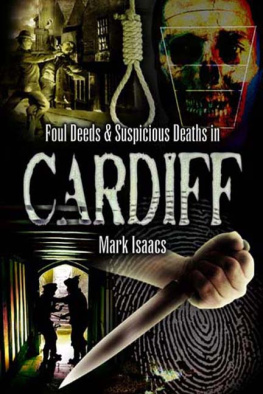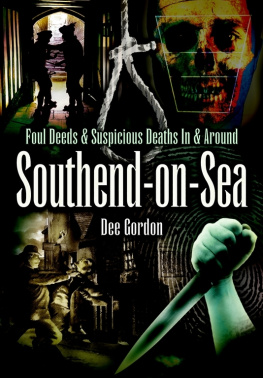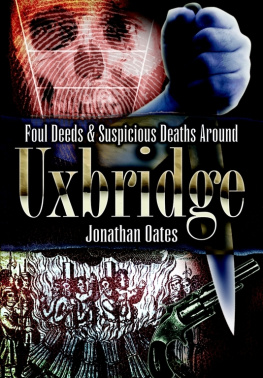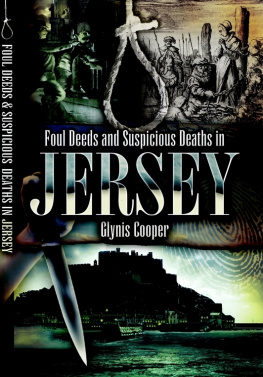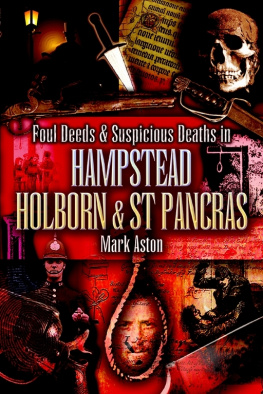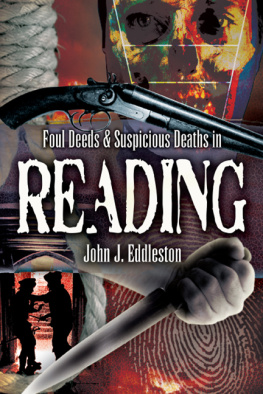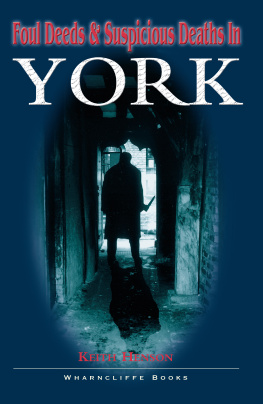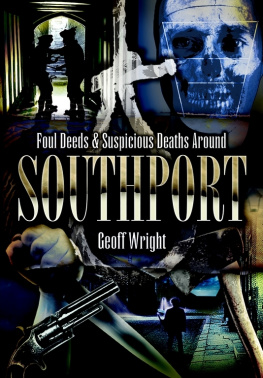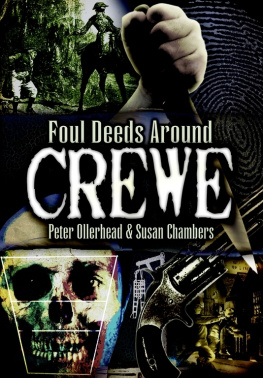
TRUE CRIME FROM WHARNCLIFFE
Foul Deeds and Suspicious Deaths Series
Barking, Dagenham & Chadwell Heath
Barnet, Finchley and Hendon
Barnsley
Bath
Bedford
Birmingham
Black Country
Blackburn and Hyndburn
Bolton
Bradford
Brighton
Bristol
Cambridge
Carlisle
Jersey
Leeds
Leicester
Lewisham and Deptford
Liverpool
Londons East End
Londons West End
Manchester
Mansfield
More Foul Deeds Birmingham
More Foul Deeds Chesterfield
More Foul Deeds Wakefield
Newcastle
Newport
Chesterfield
Colchester
Cotswolds, The
Coventry
Croydon
Derby
Dublin
Durham
Ealing
Fens, In and Around
Folkstone and Dover
Grimsby
Guernsey
Guildford
Halifax
Hampstead, Holborn and St Pancras
Huddersfield
Hull
Norfolk
Northampton
Nottingham
Oxfordshire
Pontefract and Castleford
Portsmouth
Rotherham
Scunthorpe
Shrewsbury and Around Shropshire
Southampton
Southend-on-Sea
Staffordshire and The Potteries
Stratford and South Warwickshire
Tees
Uxbridge
Warwickshire
Wigan
York
OTHER TRUE CRIME BOOKS FROM WHARNCLIFFE
A-Z of London Murders, The
A-Z of Yorkshire Murders, The
Black Barnsley
Brighton Crime and Vice 1800-2000
Crafty Crooks and Conmen
Durham Executions
Essex Murders
Executions & Hangings in Newcastle and Morpeth
Great Hoaxers, Artful Fakers and Cheating Charlatans
Norfolk Mayhem and Murder
Norwich Murders
Plot to Kill Lloyd George
Romford Outrage
Strangeways Hanged
Unsolved Murders in Victorian & Edwardian London
Unsolved London Murders Unsolved
Norfolk Murders Unsolved
Yorkshire Murders
Warwickshires Murderous
Women Yorkshire Hangmen
Yorkshires Murderous Women
Please contact us via any of the methods below for more information or a catalogue
WHARNCLIFFE BOOKS
47 Church Street, Barnsley, South Yorkshire, S70 2AS
Tel: 01226 734555 734222 Fax: 01226 734438
email: enquiries@pen-and-sword.co.uk
website: www.wharncliffebooks.co.uk


First Published in Great Britain in 2009 by
Wharncliffe Local History
an imprint of
Pen and Sword Books Ltd.
47 Church Street
Barnsley
South Yorkshire
S70 2AS
Copyright Mark Isaacs 2009
ISBN: 978-1-84563-084-3
eISBN: 978-1-78303-744-5
The right of Mark Isaacs to be identified as Author of this Work has been asserted by him in accordance with the Copyright, Designs and Patents Act 1988.
A CIP catalogue record for this book is available from the British Library.
All rights reserved. No part of this book may be reproduced or transmitted in any form or by any means, electronic or mechanical including photocopying, recording or by any information storage and retrieval system, without permission from the publisher in writing.
Typeset in 11/13pt Plantin by Concept, Huddersfield.
Printed and bound in England by
CPI UK.
Pen & Sword Books Ltd incorporates the Imprints of Pen & Sword Aviation, Pen & Sword Maritime, Pen & Sword Military, Wharncliffe Local History, Pen & Sword Select, Pen & Sword Military Classics, Leo Cooper, Remember When, Seaforth Publishing and Frontline Publishing.
For a complete list of Pen & Sword titles please contact
PEN & SWORD BOOKS LIMITED
47 Church Street
Barnsley
South Yorkshire
S70 2BR
England
E-mail: enquiries@pen-and-sword.co.uk
Website: www.pen-and-sword.co.uk
Contents
Acknowledgements
T his book is dedicated to my beautiful partner in crime Andrea Boyce without whose encouragement I probably would never have taken up this project and who proved to be a source of inspiration and a lovely distraction in equal measure. Thank you darling.
Special thanks to my old friend Marc Saltmarsh, Cardiffs answer to Quincy ME, whose medical knowledge and set of wheels to tour the badlands proved vital.
A big thank you to my colleagues in the Local Studies department of Cardiff Central Library for their patience and Brian Lee, a top-notch Cardiffian who pointed me in the right direction for the book. Last but not least thanks to Rupert Harding and Brian Elliott at Pen & Sword Books.
Chapter 1
William McKenzie and the Cardiff Police
Crime and bad lives are a measure of a States failure all crime in the end is the crime of the community
H G Wells
T he publication of the infamous Blue Book of Criminal Statistics in May 1900 succeeded in identifying Glamorgan as the most criminally inclined county in Wales. The propensity for violence and drunkenness were to top its roll call of shame. It is, however, perhaps surprising that its sister authority administered by the Cardiff Borough force was simultaneously (on paper at least) enjoying a remarkable decline in criminal activity. This was no mean feat when one considers that Cardiff was undergoing the most important and industrious period in its history, coping with a population explosion and its dockland Tiger Bay community both celebrated and feared throughout the seafaring world. Chief Superintendent William McKenzie, witnessed the size of Cardiff (and his responsibility) double. A population increase of over 50,000 in 10 years to a then high point of 190,000 is probably woefully underestimated. The extraordinarily transient population of a section of the docklands could never be accurately accounted for. It could well be argued that the reason for this period of social stability during a time of extreme economic and social change was McKenzies tenure as head of the Cardiff force. As the admiring cult of McKenzie grew, the Watch Committee wasted little time in dubbing him half a force in himself.
This was not to say that the city had become a haven of lawful tranquillity. Far from it. As late as July 1909 Cardiff Borough was vilified by the reformers of The Humane Review journal as being in the grip of flagellomania the enthusiastic deployment of the cat o nine tails as both a deterrent and a punishment to those involved in cases of robbery with violence. At a time when both Merthyr and Swansea had officially abandoned its use, Cardiff was seen to be overly keen to dispense its biting swing on all sorts of felon. The liberally inclined South Wales Daily News in many ways superseded the moralising tone of the Tory biased Western Mail in its approval of said punishment. So called Lists of the Lashed were published at regular intervals. In an article dubbed by the Humane Review an ecstasy of admiration, the South Wales Daily News was to report: Cardiff has its lions share of hooligans but (flogging) will eliminate many. The police are MORE than satisfied with the results of the cat punishment. Despite protestation from all quarters reaching as far as Home Secretary William Gladstone, Judge Justice Lawrence, the object of intense scorn for penal reformers, had that year in Cardiff sentenced seventeen-year-old Patrick Shannon to twelve months hard labour and twelve lashes. All this despite his youth, previous good conduct and absence of aggravation in the crime. These were indeed hard times for some in the city. The year 1909 would also see 291 constables on the streets of the city. This was their highest number to date and over double the manpower available to William McKenzie at the start of his tenure as Chief Superintendent.
Next page
